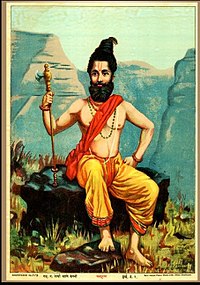| Parashu | |
|---|---|
 Parasurama holding a parashu in his right hand | |
| Type | Axe |
| Place of origin | India |
The parashu (Sanskrit language: paraṣu) is an Indian battle-axe. It is generally wielded with two hands but could also be used with only one.
Construction[]
The parashu could be double edged or bladed or single-bladed with a spike on the non cutting edge. It usually measures between 3 – 5 feet though some are as long as 7 feet. The parashu is usually made of iron or wootz steel. The cutting edge is broader than the edge which is attached to the haft. The haft is often tied with a leather sheet to provide a good grip.
In Hinduism[]
The parashu is the weapon of Lord Shiva who gave it to Parashurama, sixth Avatar of Vishnu, whose name means "Rama with the axe" and also taught him its mastery. He was one of the few Brahmin guru who were also masters of hand to hand combat. He is known as the founder of Kalaripayattu, ancient Indian martial art. Parashurama was the guru of Dronacharya, the guru who instructed the Pandavas in the epic of the Mahabharata. Bhishma and Karna, half brother of Pandava also took instruction in weaponry from Parashurama, a disciple of lord Shiva, and was known to have terrible temper having lost his father to the evil Asura. In his anger, Parashurama used the parashu to get rid of the all the Earth's tyrannical kshatriya (warrior class) twenty one times over. Parashurama's weapon had supernatural powers. It had four cutting edges, one on each end of the blade head and one on each end of the shaft.
The parashu was known as the most lethal close combat weapons of the epics. It is also one of the weapons of Lord Shiva and Goddess Durga and is still depicted on their idols throughout India.
The original article can be found at Parashu and the edit history here.